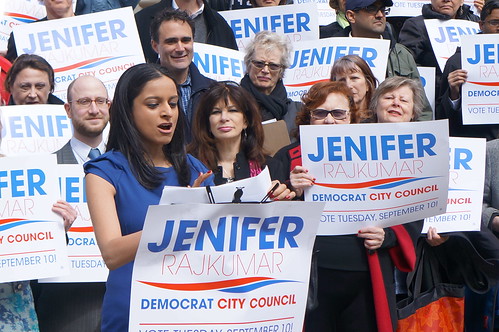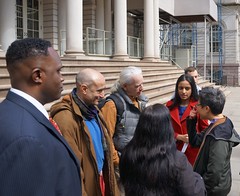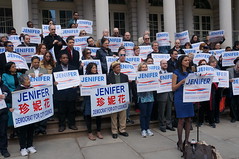Last Sunday a diverse group of 80-odd people gathered at the steps of City Hall to support Jenifer Rajkumar’s announcement that she will run against first-term council member Margaret Chin in the District 1 City Council race. The fresh-faced civil rights lawyer and former healthcare advocate at the National Women’s Law Center has spent the past two years as a district leader for the Democratic Party. Though only 30 years old, Ms. Rajkumar has already made some waves as an activist in Lower Manhattan – she’s showed up at City Hall to join Save our Seaport in opposing an unclear land-use deal and was kicked out of City Hall last summer along with others who protested N.Y.U.’s expansion plan.
At the kickoff, Ms. Rajkumar greeted constituents in Spanish, Chinese, and Yiddish. Promising a “bottom up” approach and increased transparency if elected, she asserted that, “rather than being kicked out of City Hall, we need a voice in City Hall.”
Yesterday The Local sat down with Ms. Rajkumar to get a better sense of her vision and policy goals for downtown Manhattan.
You’ve said that your parents immigrated to Queens from India with just $300 and a suitcase. Why did they come here?
My parents are physicians and the one thing they had when they moved here was an education. They were young and wanted a fresh opportunity, so they just left everything they knew to come to a country with a new language and culture. They worked hard, they struggled, and they taught me the value of hard work, perseverance and the importance of following your dreams. The biggest thing they taught me was the value in serving the under-served.
You’ve been a district leader for almost two years in Lower Manhattan. What is the biggest challenge you’ve noticed in the area?
Population explosion. Since 2001 the population of Lower Manhattan has increased by 91 percent according to U.S. Census bureau. We have all these young families moving downtown, along with young professionals, joining people who have been there decades. This has created new challenges, including school overcrowding and housing issues.
Tell us about your stance on land use and affordable housing in the area.
I think that affordable housing is a huge issue both in Chinatown and the L.E.S.
Specifically, looking at the N.Y.C.H.A. infill development program that has been proposed, I think there’s real concerns and real fears in the community about what’s going to happen to them and their open space – their playgrounds, and parking lots – that the infill development will get rid of. This will greatly impact the quality of life for these residents and it’s a very serious concern.
I really think we need to look very carefully at this N.Y.C.H.A. infill development proposal and we need to ask tough questions and hold N.Y.C.H.A. accountable. For example, two weeks ago the federal housing authority slammed N.Y.C.H.A. for sitting on top of $1 billion since 2010, all while N.Y.C.H.A. is saying that they have to lease land to raise more money for repairs. But what about the $1 billion from 2010? It could be that N.Y.C.H.A. has the money. We have to make sure this plan is the best thing for the community.
What experience will you bring to these struggles?
One thing I’m very excited about is how I’ll be able to bring my negotiating skills to that endeavor. As a civil rights lawyer I’ve had to sit across from corporate executives and fight for the little people. I think that skill translates very well into being a council member. That means sitting across from developers at the table and extracting concessions for the community, extracting as much affordable housing as we can, and new schools, and an environment where small businesses can thrive.
What do you think about the Business Improvement District (BID) in Chinatown (spearheaded by Margaret Chin)?
I am highly skeptical of the BID in Chinatown, also in SoHo. I think that BIDs are a tax burden, and before we burden residents with this extra tax, we need to ask: what are they getting? I think that we need to make sure there is full community input in these decisions before creating a BID.
BIDs perform many of the activities that the City is already supposed to perform. For example, the City is responsible for cleaning streets, so before we impose these tax burdens on residents we have to ask if the BID is really necessary and if there is a better way to achieve the objectives.
In light of the ongoing “Stop and Frisk” federal trial, what are your thoughts on the practice?
I think that stop and frisk creates distrust between law enforcement and minority communities. To really ensure safety of our communities, minority community and law enforcement needs to work together. We all want the same thing, we want safe communities. I’m very hopeful with the court case current going on against stop and frisk. Putting my “lawyering cap” on, I’m very hopeful that stop and frisk will be declared unconstitutional because I believe it violates the fourth amendment on search and seizure, and the 14th amendment, guaranteeing equal protection
As district leader I’ve worked with the Police Reform Organizing Project (PROP). I’ve stood on the street with them outside of Tompkins Square Park to get people to sign a petition to end the practice of stop and frisk and I’ve also stood with our Manhattan Borough President, Scott Stringer at a public rally against stop and frisk.
Can you give us more details on the bottom up approach you are calling for, and how it relates to City Council?
One of the most important things that I am going to do as a council member and that I’m already doing as a district leader is making government more inclusive and bringing marginalized, excluded, vulnerable people into the process.The top down approach is more of what we’ve been seeing in the council: a council member makes a deal with an outside interest or an outside developer, goes into a room with them, shuts the door on the people, and makes the deal. That is something I would never do — my door would never be shut on the people.
There’s so many ways to implement the bottom-up approach to leadership as a council member. One of those that I’m excited about is participatory budgeting. In participatory budgeting, people across the district get to vote on how they want the council’s funds spent. This is a new model – it was created in 1989 and first used in Brazil. It has begun to be implemented by certain council members (like Council Member Jumaane Williams and Progressive Caucus Chair Melissa Mark-Viverito) across the city and I’m very excited to implement this as part of a bottom-up approach.
Where would you take an out-of-town visitor in New York?
I would take them to Jing Fong Restaurant. It’s Chinatown’s largest unionized restaurant, but it’s also simply a fun place to go. So many people come to eat at this huge dining hall and they serve dim-sum.
Then we’d go to the Tenement Museum, because it shows the fascinating immigrant history of the Lower East Side.
At night we’d go to Karaoke Boho on Orchard street near Katz’s Deli to sing late into the night.
If you could go back in time to downtown New York of the past, what time period would you want to visit?
I would go to the Gilded Age in the late 1800s, early 1900s, because it was a time of great economic stratification of the very wealthy and the very poor. I’d love to draw parallels between the Gilded Age and now and see what I could learn from that. It was also a powerful time for reform movements — the women’s suffrage movement was in full swing at that time — and I’d like to take a cue to learn from the past to better inform the present.
This interview has been condensed and edited.






